Abstract
Haptic feedback for flexible endoscopic surgical robots is challenging due to space constraints for sensors and shape-dependent force hysteresis of tendon-sheath mechanisms (TSMs). This paper proposes (1) a single-axis fiber Bragg grating (FBG)-based force sensor for a TSM of a robotic arm and (2) an integrated sensor-model approach to estimate forces on other TSMs of that arm. With a robust and simple structure, a temperature-compensated sensor can be mounted on the distal sheath to measure forces applied by the TSM. This proposed sensor was integrated with a Ø4.2 mm articulated robotic arm driven by six TSMs, with a measurement error of 0.37 N in this work. The measurement from the single sensor was used to identify parameters in the force-transmission models of all other TSMs in the robot, realizing a one-sensor-for-all-distal-forces measurement method. The sensor-model approach could accurately estimate the distal force with an RMSE of 0.65 N. An animal study was carried out to demonstrate the sensor’s feasibility in real-life surgery. The sensor-model approach presented a robust, space-saving, and cost-effective solution for haptic feedback of endoscopic robots without any assumption on the shapes of the robot.








Similar content being viewed by others
References
Agrawal, V., W. J. Peine, and B. Yao. Modeling of transmission characteristics across a cable-conduit system. IEEE Trans. Robot. 26(5):914–924, 2010.
Arabagi, V., O. Felfoul, A. H. Gosline, R. J. Wood, and P. E. Dupont. Biocompatible pressure sensing skins for minimally invasive surgical instruments. IEEE Sens. J. 16(5):1294–1303, 2016.
Cao, L., X. Li, P. T. Phan, A. M. H. Tiong, H. L. Kaan, K. Y. Ho, P. W. Y. Chiu, and S. J. Phee. A flexible endoscopic robotic suturing system for gastrointestinal perforations: animal study. In: Hamlyn Symposium on Medical Robotics, 2019.
Cao, L., X. Li, P. Phan, A. Tiong, J. Liu, and S. J. Phee. A novel robotic suturing system for flexible endoscopic surgery. In: International Conference on Robotics and Automation. Montreal, Canada, 2019.
Do, T. N., T. Tjahjowidodo, M. W. S. Lau, T. Yamamoto, and S. J. Phee. Hysteresis modeling and position control of tendon-sheath mechanism in flexible endoscopic systems. Mechatronics 24(1):12–22, 2014.
Feng, J., Y. Yahui, Z. Zhao, et al. A variable-impedance piezoelectric tactile sensor with tunable sensing performance for tissue hardness sensing in robotic tumor palpation. Smart Mater. Struct. 27(11):115039, 2018.
Gao, A., Y. Zhou, L. Cao, Z. Wang, and H. Liu. Fiber Bragg grating-based triaxial force sensor with parallel flexure hinges. IEEE Trans. Ind. Electron. 65(10):8215–8223, 2018.
Gu, X., C. Li, X. Xiao, C. M. Lim, and H. Ren. A compliant transoral surgical robotic system based on a parallel flexible mechanism. Ann. Biomed. Eng. 2019. https://doi.org/10.1007/s10439-019-02241-0.
He, X., J. Handa, P. Gehlbach, R. Taylor, and I. Iordachita. A submillimetric 3-DOF force sensing instrument with integrated fiber bragg grating for retinal microsurgery. IEEE Trans. Biomed. Eng. 61(2):522–534, 2014.
Hill, K. O., and G. Meltz. Fiber Bragg grating technology fundamentals and overview. J. Lightwave Technol. 15(8):1263–1276, 1997.
Kaneko, M., T. Yamashita, and K. Tanie. Basic considerations on transmission characteristics for tendon drive robots. Paper Presented at Advanced Robotics, 1991. Fifth International Conference on ‘Robots in Unstructured Environments’, 91 ICAR, 1991.
Khoshnam, M., and R. V. Patel. Robotics-assisted control of steerable ablation catheters based on the analysis of tendon-sheath transmission mechanisms. IEEE/ASME Trans. Mechatron. 22(3):1473–1484, 2017.
Kim, U., Y. B. Kim, D. Y. Seok, J. So, and H. R. Choi. A surgical palpation probe with 6-axis force/torque sensing capability for minimally invasive surgery. IEEE Trans. Ind. Electron. 65(3):2755–2765, 2018.
Lai, W., L. Cao, Z. Xu, P. T. Phan, P. Shum, and S.J. Phee. Distal end force sensing with optical fiber Bragg gratings for tendon-sheath mechanisms in flexible endoscopic robots. Paper Presented at 2018 IEEE International Conference on Robotics and Automation (ICRA), 2018.
Le, H. M., T. N. Do, L. Cao, S.J. Phee. Towards active variable stiffness manipulators for surgical robots. Paper Presented at 2017 IEEE International Conference on Robotics and Automation (ICRA), 2017.
Li, X., L. Cao, A. M. H. Tiong, P. T. Phan, and S. J. Phee. Distal-end force prediction of tendon-sheath mechanisms for flexible endoscopic surgical robots using deep learning. Mech. Mach. Theory 134:323–337, 2019.
Li, T., C. Shi, and H. Ren. A high-sensitivity tactile sensor array based on fiber Bragg grating sensing for tissue palpation in minimally invasive surgery. IEEE/ASME Trans. Mechatron. 2018. https://doi.org/10.1109/tmech.2018.2856897.
Li, T., C. Shi, and H. Ren. Three-dimensional catheter distal force sensing for cardiac ablation based on fiber Bragg grating. IEEE/ASME Trans. Mechatron. 23(5):2316–2327, 2018.
McKinley, S., A. Garg, and S. Sen, et al. A single-use haptic palpation probe for locating subcutaneous blood vessels in robot-assisted minimally invasive surgery. Paper Presented at 2015 IEEE International Conference on Automation Science and Engineering (CASE), 2015.
Pacchierotti, C., D. Prattichizzo, and K. J. Kuchenbecker. Cutaneous feedback of fingertip deformation and vibration for palpation in robotic surgery. IEEE Trans. Biomed. Eng. 63(2):278–287, 2016.
Ren, F., W. Zhang, Y. Li, Y. Lan, Y. Xie, and W. Dai. The temperature compensation of FBG sensor for monitoring the stress on hole-edge. IEEE Photonics J. 10(4):1–9, 2018.
Srivastava, A., R. Xu, A. Escoto, C. Ward, and R. V. Patel. Design of an ultra thin strain sensor using superelastic nitinol for applications in minimally invasive surgery. Paper Presented at 2016 IEEE International Conference on Advanced Intelligent Mechatronics (AIM), 2016.
Su, H., W. Shang, G. Li, N. Patel, and G. S. Fischer. An MRI-guided telesurgery system using a Fabry-Perot interferometry force sensor and a pneumatic haptic device. Ann. Biomed. Eng. 45(8):1917–1928, 2017.
Sun, Z., Z. Wang, and S. J. Phee. Elongation modeling and compensation for the flexible tendon-sheath system. IEEE/ASME Trans. Mechatron. 19(4):1243–1250, 2014.
Wagner, C. R., N. Stylopoulos, P. G. Jackson, and R. D. Howe. The benefit of force feedback in surgery: examination of blunt dissection. Presence Teleoperators Virtual Environ. 16(3):252–262, 2007.
Zarrin, P. S., A. Escoto, R. Xu, R. V. Patel, M. D. Naish, and A. L. Trejos. Development of a 2-DOF sensorized surgical grasper for grasping and axial force measurements. IEEE Sens. J. 18(7):2816–2826, 2018.
Zhou, Z., and J. Ou. Techniques of temperature compensation for FBG strain sensors used in long-term structural monitoring. Paper Presented at Fundamental Problems of Optoelectronics and Microelectronics II, 2005.
Acknowledgments
This work was supported by the National Research Foundation (NRF), Singapore (NRFI2016-07).
Author information
Authors and Affiliations
Corresponding author
Additional information
Associate Editor Tingrui Pan oversaw the review of this article.
Publisher's Note
Springer Nature remains neutral with regard to jurisdictional claims in published maps and institutional affiliations.
Rights and permissions
About this article
Cite this article
Lai, W., Cao, L., Tan, R.X. et al. An Integrated Sensor-Model Approach for Haptic Feedback of Flexible Endoscopic Robots. Ann Biomed Eng 48, 342–356 (2020). https://doi.org/10.1007/s10439-019-02352-8
Received:
Accepted:
Published:
Issue Date:
DOI: https://doi.org/10.1007/s10439-019-02352-8




